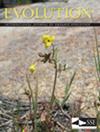Spider silk tensile performance does not correlate with web use.
IF 3.1
2区 环境科学与生态学
Q2 ECOLOGY
引用次数: 0
Abstract
Spider silk is amongst the toughest materials produced by living systems, but its tensile performance varies considerably between species. Despite the extensive sampling of the material properties and composition of dragline silk, the understanding why some silks perform better than others is still limited. Here, I adopted a phylogenetic comparative approach to re-analyse structural and mechanical data from the Silkome database and the literature across 164 species to (a) provide an extended model of silk property evolution, (b) test for correlations between structural and mechanical properties, and (c) to test if silk tensile performance differs between web-building and non-web-building species. Unlike the common notion that orb-weavers have evolved the best performing silks, outstanding tensile properties were found both in and outside the araneoid clade. Phylogenetic linear models indicated that the mechanical and structural properties of spider draglines poorly correlate, but silk strength and toughness correlated better with birefringence (an indicator of the material anisotropy) than crystallinity. Furthermore, in contrast to previous ideas, silk tensile performance did not differ between ecological guilds. These findings indicate multiple unknown pathways towards the evolution of spider silk tensile super-performance, calling for a better integration of non-orb-weaving spiders in spider silk studies.蜘蛛丝的拉伸性能与蜘蛛网的使用无关。
蜘蛛丝是生物系统产生的最坚韧的材料之一,但不同种类的蜘蛛丝拉伸性能差异很大。尽管对拖拉机蛛丝的材料特性和组成进行了大量取样,但人们对某些蛛丝的性能为何优于其他蛛丝的了解仍然有限。在此,我采用系统发育比较方法,重新分析了 Silkome 数据库和文献中 164 个物种的结构和机械数据,以(a)提供一个丝特性进化的扩展模型,(b)检验结构和机械特性之间的相关性,以及(c)检验造网物种和非造网物种之间的丝拉伸性能是否存在差异。与认为织网动物进化出了性能最好的丝的普遍观点不同,在类人猿支系内外都发现了出色的拉伸性能。系统发育线性模型表明,蜘蛛拖丝的机械和结构特性相关性很差,但丝的强度和韧性与双折射(材料各向异性的指标)的相关性比结晶性更好。此外,与以前的观点不同,不同生态区的蛛丝拉伸性能并无差异。这些发现表明蛛丝超强拉伸性能的进化有多种未知途径,因此需要在蛛丝研究中更好地结合非织造蜘蛛。
本文章由计算机程序翻译,如有差异,请以英文原文为准。
求助全文
约1分钟内获得全文
求助全文
来源期刊

Evolution
环境科学-进化生物学
CiteScore
5.00
自引率
9.10%
发文量
0
审稿时长
3-6 weeks
期刊介绍:
Evolution, published for the Society for the Study of Evolution, is the premier publication devoted to the study of organic evolution and the integration of the various fields of science concerned with evolution. The journal presents significant and original results that extend our understanding of evolutionary phenomena and processes.
 求助内容:
求助内容: 应助结果提醒方式:
应助结果提醒方式:


